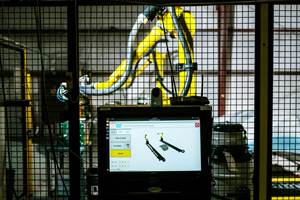Machine Conditions and Cutting Rate
Has anyone accurately determined the advantages of amplitude versus frequency for deburring?
Q. Some staff in our shop say high amplitude is more beneficial to metal removal than high frequency; others point out that we can increase the deburring in our machines with variable-speed drives by increasing the frequency. Our round machines do not have variable speed drives, while our two tub machines do. We have experimented with both styles, increasing amplitudes and, when possible, frequencies, but our results are not conclusive. In the tub machines, when we increase the frequency there is faster metal removal but also a slight increase in amplitude. We haven’t been able to change just one variable at a time. In the bowl machines we can cut faster than the tubs by increasing the amplitude, but we are unable to get the same amplitude at the same frequency in the tubs. This is all academic because we direct the work to certain machines for reasons other than cut, such as part size, separation considerations or plant location. We wonder, though, if anyone has accurately determined the advantages of amplitude versus frequency for deburring. C.D.
A. You hear this argued both ways, and, to a degree, both sides are right. This is a good time to ask for input from equipment manufacturers—especially manufacturers of tub and bowl machines. In the meantime, I’ll share what I’ve learned from limited testing and some published data.
Before starting, let me point out that metal removal in mass finishing machines can be compared to filing an edge with a hand file. More pressure gives faster cutting, longer strokes are advantageous, and filing faster back and forth will get the job done more quickly. It stands to reason that longer strokes and faster action with more pressure will be the quickest. Hand filing enables you to independently vary any action. Not so in mass finishing.
The earliest test data I saw was by 3M Co. in the 1960s, titled “Vibratory Finishing. Effects of Significant Variables.” (My incomplete copy does not contain the publishing date or copyright information. If anyone has the complete booklet, I would appreciate a copy for my reference.) This is one of few published studies that address your question. I supplement it with tests I’ve conducted and with conversations with others in the business.
The 3M study measured the effect of 1) compound flow rates; 2) load depth; 3) media abrasiveness; 4) media density; 5) vibratory frequency at 1,500, 1,800 and 2,100 rpm; 6) media size; 7) part loading; 8) fixtured parts versus loose parts; and 9) compound lubricity. When you consider all the variables they attempted to measure, you realize it was impractical to make measurements when only one factor was changed in each test series. For example, when you change the density of the media, you necessarily reduce the amplitude unless making offsetting changes to the eccentric weights. The same is true when you change the load depth or frequency. The 3M study concluded that higher amplitude increases cutting more effectively than higher frequency. It also showed that load depth and compound flow rates affect the cutting rate.
Because bowl machines can obtain higher amplitudes and still have a smooth rolling action, it is my experience that bowl machines can be set to outperform tub machines when cutting rate and part integrity are the criteria. The apples-to-apples comparisons are skewed by several factors, including differing bowl depths.
OK, machine manufacturers, let’s hear from you on this subject.
Related Content
AI-Powered Robotic Solutions Support High-Mix Finishing
AI startup offers automation innovations for high-mix, high-variability, manual surface finishing applications.
Read MoreWall Colmonoy Hires Business Development Manager, Surfacing Products
Wall Colmonoy welcomes Josh Gardner as its business development manager of surfacing products.
Read MoreUnderstanding Shot Peening
A look inside shot peening — a process of “hammering” of work pieces with precisely defined blast media.
Read MoreVulkan Blast Shot Technology
Vulkan Blast Shot Technology is a pioneer in the stainless steel abrasives market.
Read MoreRead Next
Education Bringing Cleaning to Machining
Debuting new speakers and cleaning technology content during this half-day workshop co-located with IMTS 2024.
Read MoreA ‘Clean’ Agenda Offers Unique Presentations in Chicago
The 2024 Parts Cleaning Conference, co-located with the International Manufacturing Technology Show, includes presentations by several speakers who are new to the conference and topics that have not been covered in past editions of this event.
Read MoreEpisode 45: An Interview with Chandler Mancuso, MacDermid Envio Solutions
Chandler Mancuso, technical director with MacDermid Envio discusses updating your wastewater treatment system and implementing materials recycling solutions to increase efficiencies, control costs and reduce environmental impact.
Read More














.jpg;maxWidth=300;quality=90)










